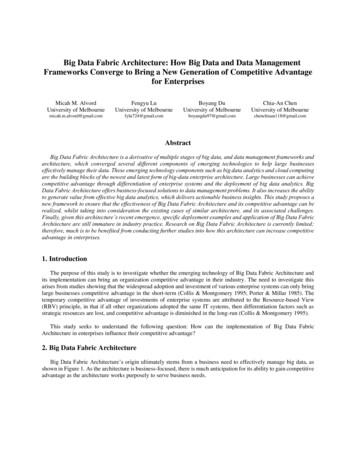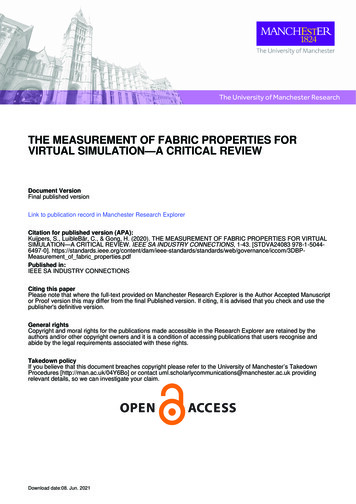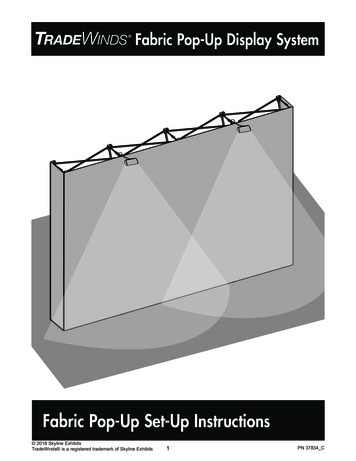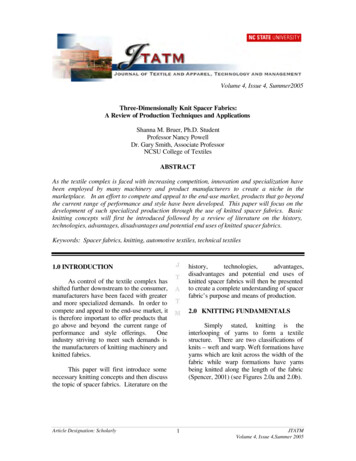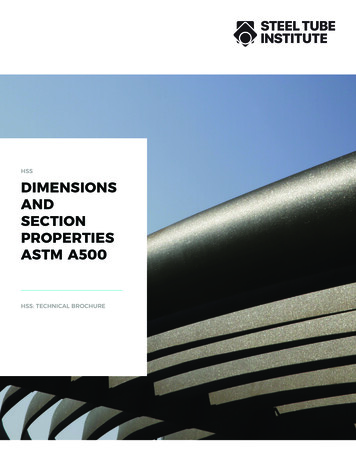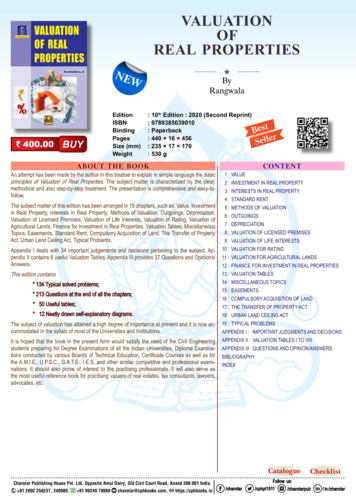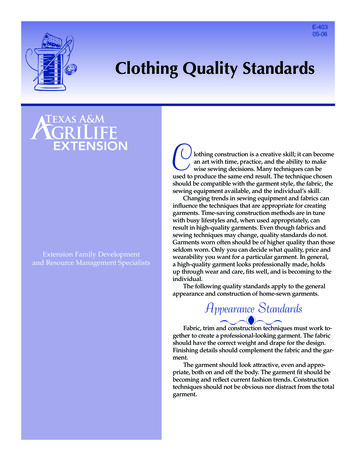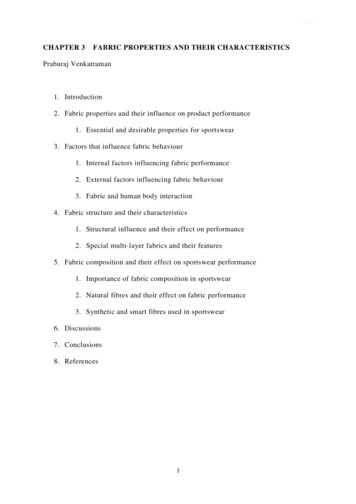
Transcription
Jai Shri RamCHAPTER 3FABRIC PROPERTIES AND THEIR CHARACTERISTICSPraburaj Venkatraman1. Introduction2. Fabric properties and their influence on product performance1. Essential and desirable properties for sportswear3. Factors that influence fabric behaviour1. Internal factors influencing fabric performance2. External factors influencing fabric behaviour3. Fabric and human body interaction4. Fabric structure and their characteristics1. Structural influence and their effect on performance2. Special multi-layer fabrics and their features5. Fabric composition and their effect on sportswear performance1. Importance of fabric composition in sportswear2. Natural fibres and their effect on fabric performance3. Synthetic and smart fibres used in sportswear6. Discussions7. Conclusions8. References1
Jai Shri Ram1.0 INTRODUCTIONA confident understanding of fabric behaviour and characteristics are vital in the design anddevelopment of a functional garment. For instance, a warp knit mesh fabric made of 100%polyester designed to wick moisture away from the skin, with the quick dry ability, making itideal for everyday wear and preferred in extreme performance requirements. On the other hand,Georgette is a balanced plain-woven fabric generally made of 100% polyester with high twistyarns giving the fabric less smooth appearance used in fashion apparel. Textile materials haveevolved in recent times and fabrics play a significant role in the development of sportswearindustry. In fact, it reflects the quality of a brand and its identity. The primary focus of thischapter is to present the essential and the desirable properties suitable for performance apparelespecially for sportswear. Various sportswear applications are discussed to enable the readerto understand the rationale for such parameter. Generally, garments intended for fashionapparel will have to fulfil the following characteristics: durability, strength, colourfastness,aesthetics and so forth. These properties are mandatory for everyday use and maintenance forfashion apparel. However, in the case of performance apparel the requirements are functionaland application-specific properties, such as moisture transmission, thermal resistance, wicking,water proof, and flame resistant. The reason for requirements of such properties is becausefunctional apparel are subjected to a wide range of end uses such that a garment will be affectedby internal (fibres, yarn fineness, warp/weft movement, fabric density, thickness, fabric count)and external factors (external environment – exposure to sunlight, wind, rain, cold weatherconditions and during use). These factors affect the performance and behaviour of functionalapparel which are discussed in the sections with examples. In addition, the interaction betweenthe human body and garment is significant; this is true for those close-fit garments such as,base layer garments, where thermo-regulation plays a vital role in the performance of anathlete. Fabrics for sportswear are either woven or knitted and is often blended with synthetic2
Jai Shri Ramand natural fibres with varying linear density to provide an optimum performance. The heavyweight fabrics for outerwear are multi-layered (coated or laminated) and their properties differfrom light weight fabrics. Parameters of these fabrics due to structural difference arehighlighted here with specific focus on functional apparel. Fabric behaviour will be affectedby its composition and this is presented with examples. This chapter will empower the readerto understand the properties of fabrics for various performance application, and how theseparameters will affect the overall performance of the garment.2.0 FABRIC PROPERTIES AND THEIR INFLUENCE ON PRODUCTPERFORMANCEA number of fabrics are used in performance and sportswear apparel include – smartfabrics which has intelligent approach to high body or ambient temperature – the warmerthe material gets the faster the moisture management system functions – Burlington’ssmart fabric temperature management. The technology uses micro-encapsulated phasechange materials called Thermocules to absorb and release heat to enhance comfort.Light weight, stretchable and soft waterproof or breathable fabrics; fabrics made of finemicro-fibres with breathability; soft shell or three layer fabrics which are bonded as wellas laminated made of tricot warp knits or woven fabric for wind insulation or water proof;knits – with synthetic or natural fibre blends and up to 30% elastane fibres for stretch andrecovery, fleece and brushed knit made of synthetic fibres that has a natural feel, stretchyand smooth surface; woven shirts with varying fabric weight (160 to 400 g/m2 ); ecofriendly fabrics include recycled polyester; fancy fabrics with patterns, designs andfinishes, laser or etched burnt out, 3D knits, honey comb patterns and work wear andprotective wear fabrics include durable rugged finish, cut resistant, flame retardant,resistance to abrasion, reflective facings, etc. Figure 1 illustrates the type of fabrics used3
Jai Shri Ramfor fashion apparel which include woven, knitted fabrics, braids, interlining, bondedfabrics and felt. It should be noted that fabrics – woven and knitted will performdifferently due to their structural variation which is summarised in Table 1. Functionalapparel have a combination of fabrics made of woven and knitted to suit variousapplication.Figure 1: Common fabric types for apparel end useTable 1: Fabric characteristicsKnitted fabrics Woven fabricsSeries of interconnected loops made withone or more sets of yarns.Can be ravelled from top to bottom.Warp knits cannot ravel.Fabric can snag and run, bowed orskewed.Usually heavier because more yarn isused.Possess stretch and elasticity, adapts tobody movement.Good recovery from wrinkles, airpermeable.Possess open spaces between yarns andbulky.Porous and less opaque4 Two or more sets of yarns interlacedto form the fabric structure.Yarns interlace at right angles.May be bowed or skewed. Can beravelled from any cut edge.Usually lighter in weight because lessyarn is usedPossess limited stretch andadaptability to body movementBulkiness and recovery from wrinkledepends on weave structureStable to stress, less air permeable,especially with dense fabric.Provides maximum hiding power andcover
Jai Shri Ram Less stable in use and care. Highershrinkage unless heat-setMore stable in use and care. Mayshrink less than 2%In order to understand the fabric properties of garments designed for active wear it isnecessary to explore the sports trend - type of sports preferred, frequency of activities,and garments frequently purchased. In the UK, a number of sporting activities arepreferred, amongst many, swimming, running, cycling, tennis, golf and aerobics arewidely preferred (Mintel, 2011). Population involved in sports are generally youngergroup whose age range from 16 to 24 and this trend can noted across various sports.However, population in the age range 25 to 34 and 35 to 44 were also active particularlyin swimming, using gym, running, cycling and tennis.Figure 2: Number of adults taking part in sports 2005/6 and 2013/14(Source: Sportengland.org)There is a gradual and consistent increase in the number of people who involve in sportingactivities over the last eight years (Figure 2). This includes adults who take part once amonth, once a week, twice and three times a week.5
Jai Shri RamFigure 3: Top five sports played(Source: Sportengland.org)Sport England survey on the most frequently preferred sports in the UK reported thatswimming was mostly preferred to stay fit and as a sporting activity (Figure 3), followedby athletics, football, cycling and golf (www.sportengland.org). In this chapter, specificfocus will be given to those fabrics which are used in the manufacture of garments forthese sport activities.6
Jai Shri RamFigure 4: Sports clothing purchased during 2010/11in the UK(Source: Mintel, 2011)It can be noted that most of sport loving population purchase garments for casual end usesor as fashion apparel than for sporting activities. This trend was observed across all formsof garments from trainers to fleece. It should be noted that survey was based on internetusers (n 2000) who were above 16 years and among them trainers, jogging trousers, tshirts, shorts, football shirts, sweat shirts and sports jackets are popular amongconsumers. In addition, at the lower end of the segment, replica rugby shirts, waterproofjackets, fleece, leggings and vests were also popular (Figure 4). Mintel (2011) recently inits report stated that 33% of consumers purchased sportswear as a comfortable leisurewear; 21% consumers stated they would prefer branded sportswear and 46% of consumerspurchased sportswear clothing to stay physically active and to enhance their performance.This finding is interesting that the sportswear market has a good base, particularly amongyounger age group and most prefer garments to stay fit and support in their performance.7
Jai Shri RamIt is also necessary to note that sports active adults prefer functional garments for leisureactivities.2.1 Essential and desirable properties of fabricsA fabric property is a characteristic of a material, which it should possess for it to be usedin a desired application satisfactorily. In other words, it can also be termed as therequirement of a textile material for a certain purpose. In this section, various fabricproperties mandatory for performance and sportswear are highlighted. In order to identifythe desirable and essential property it is necessary to know the requirements of a specificsport (Table 2). Essential properties are those that are necessary for a particular sporteither due to regulations or user requirement. On the other hand, desirable properties arethose which are preferred by users for aesthetics and appearance. Let us explore the someof the widely preferred sports. It should be noted each and every sport has differentrequirements based on the nature and intensity at which they are played. However it isassumed these are at professional level and include those fabrics that are used for casual,fitness and sporting activities.GolfFootballTable 2 : Major sports and parameters requiredESSENTIALDESIRABLE PROPERTYTYPE OF SPORT ANDPROPERTY OF FABRICOF FABRICGARMENTS USEDTypical garments Moisture (sweat) Aestheticsinclude tops, trousers,management Sensorial comfortbase layer tights, Breathable Soft next to the skinsocks, compression Anti-clingtops and shorts, soft Anti-staticshell jacket, and knee Light weight fabricsupport Anti-odour Durable Washable Colour fastnessshirts, trousers, Comfort Colourfastnessjackets, water proof Moisture management Smooth to skinjackets and socks Thermal insulation Aesthetics – creaserecovery and stiffness Durable Soil resistant8
SwimmingCyclingJai Shri RamBib shorts, cyclingshoes, short sleevedjersey, base layervests, fingerlessgloves, socks, and cap Stretch and recoverySweat absorptionWickingCompressionBreathableWind proofAnti-odourUV protectionswim suit, boardshorts, jammers, racerback suits, swimbriefs, body suits, andsoft-shell jackets. Chlorine resistantfabricLow moistureabsorption rateColour resistantQuick dryingImproved elasticityDrag-resistantFour-way stretchLight weightKeep coolSweat management(wicking)BreathableSustainable (naturalfibres)Water proof (jackets)Thermal insulation(fleece)Compression (baselayer)Body suits, tops, tshirts, shorts, tracksuits, leotards, sportsbra Athletics Long lasting fitDurable (good burstingstrength)Fabric stability Soft feel to the skinShape retentionImproved comfortSupport in garment fitAnti-bacterialUV protection Snag resistanceAestheticsColourfastnessWater repellentSome other properties of fabrics/garments required in performance apparel Absorb moisture readily Easy to dispose Appearance Easy to maintain Attractive Fabric hangs freely Bend repeatedly without Good surface texturebreaking Impact protection Conceal or protect Lustre Dimensionally stable Non-absorbent9
Jai Shri Ram Protect the body Transfer or maintain heat Resilient Wick moisture readily Resistant to insect damage Withstand degradation from Resistant to mildew Shrinkage resistant Withstand pulling force Soft-next-to-skin Withstand use Stretch without breaking Transfer electric chargessunlightFigure 5: Fabric properties10
Jai Shri RamFigure 5 illustrates the properties of fabrics which are classified into four sections,durability, aesthetics, comfort and maintenance of a garment on a day-to-day basis. Theterminology of various fabric properties are presented in Table 3 with specificapplication.CASE STUDY: A cycling enthusiast- fabric requirementsA cross-country cyclist* illustrated in the picture is a regular cyclist who uses biketraining twice a month. Each occasion can involve from five to seven hours ofintensive cycling. The garments that the cyclist uses include bib-shorts and tops. Inaddition, elbow support and shinbone protection for the lower limb is part of the kit.Some of the properties that the cyclist prefers in their garments are:1. Light weight2. Economical3. Durable4. Washable5. Easy to wear6. Soft next to the skin7. Breathable8. Moisture absorbent9. Practical (fit for purpose)10. EconomicalIt could be noted that the cyclist who is a professional who wants to involve in the sportas a recreation as well as to keep fit. The cyclist pays significant attention to the clothinggear and desires to wear garments that allows free movement as well as protect frominjuries.11
Jai Shri RamCategoryTable 3: Fabric properties and their applicationTextile parameterBreaking strengthDurabilityTearing strengthBursting strengthAbrasion resistancePilling resistanceSurface frictionAestheticsFabric drapeStiffness(Fabric handle)Crease recoveryDefinitionSuitabilityForce required to break aWoven fabricfabric when it is under tensionForce required to continue arip already started in thefabricWoven fabricAmount of pressure requiredto rupture a fabricKnitted fabric, felts,nonwoven fabric, laceResistance to wear away ofany part of material whenrubbed against anothermaterialFormation of pill or fuzz onthe surface of the fabricAll fabric andapplicationsHydrophobic fibres andfabrics with inferioryarn qualityAbility to offer resistance toFabrics with low yarnsrubbing force or sliding action per inchThe ability of the fabric todrape or to hang on its ownweight to follow the bodycontours and gracefulfolds/curves.Woven and knittedfabricsIt determines the bendinglength of the fabric or abilityof the fabric to bend under itsown weight at a specifiedangleWoven, nonwovenfabrics in both directionsAbility of the fabric to resistcreasingWool/silk - highresistance to creases,cellulose fibres poorresistance12
Jai Shri RamDimensionalstabilityAir uctivityWater proofStretch and recoveryColourfastness towashingMaintenanceColourfastness toRubbingColourfastness toLightStorageColourfastness toPerspirationResistance tomoths/insectsThe ability of the fabric toremain stable without changein its dimension after washingWoven and knittedfabricsAbility of the fabric to allowpassage of air through itssurface at a specified pressuredifference over a certainperiod.Ability of the fabric to allowmoisture vapour to passthrough its structureDense woven fabricAbility to conduct heat (Km/W); implies the quantityof heat that passes in unit timethrough a plateof particular area andthicknessResistance to waterpenetrationGarments for outer doorwearAbility of the fabric to stretchunder deformation andrecover to its original positionafter removal of deformationIt is a measure of howpermanent a colour remainson the fabric during washingKnitted fabrics withelastane compositionTo determine the effect ofcolourfastness in wet and dryrubbing actionWoven and knittedfabrics that bright ordark colouredTo determine the effect ofcolourfastness duringcontinuous exposure to lightsourceTo determine the resistance ofthe colour of textiles tohuman perspirationWoven and knittedfabrics that bright ordark coloured – outdoor/swimwearWoven and knittedfabrics that bright ordark coloured worn nextto the skin – socks,tights, etc.Fabrics with animalfibre compositionAbility of fabric to resist frommoth and insects duringstorage13Fabric with finishes withcertain coating for waterpenetrationFabrics withfilm/membrane coatingMild to darkcolour/shadedwoven/knitted fabrics
Jai Shri RamResistance to stainsAbility of the fabric tostaining during long termstorageWoven / knitted fabrics3.0 FACTORS THAT INFLUENCE FABRIC BEHAVIOURFunctional apparel will be subjected to a wide range of end uses such that a garment will beaffected by internal (fibres, yarn fineness, warp/weft or course/;wale movement, fabric density,thickness, fabric count) and external factors (external environment – exposure to sunlight,wind, rain, cold weather conditions, fabric/human body interaction). These factors affect theperformance and behaviour of functional apparel which are discussed in the sections withexamples.3.1 Internal factors influencing fabric performanceFabric is either interlaced with one or more set of yarns or interconnected with loop ofyarns, which are composed of fibres and filaments, and it is the fundamental element. Inperformance apparel a wide range of synthetic filaments such as nylon, polyester,elastane, acrylic and so forth are widely used. Fabric behaviour is affected by fibre blendsand their fineness (McGregor and Naebe, 2013). Similarly, yarn quality (count) is pivotalin producing a uniform fabric texture. Some of the yarn quality parameters such as yarntwist, number of folds, and yarn count affect fabric characteristics. For instance, a finequality yarn made of fine denier filament will possess a supple and pliable fabric that haslow drape coefficient. On the other hand, a coarse yarn will produce a stiff fabric that hashigh drape. There is effect of fibre type, yarn quality and fabric attributes on fabricperformance. McGregor and Naebe (2013) reported the comfort properties of 81 single jerseyknitted fabrics with varying fibre, yarn and fabric attributes. The research studied the comfortproperties of wool knitted fabrics with 27 types of fibre blends, 16 types of yarn and 30 different14
Jai Shri Ramfabrics. Authors reported that tighter fabrics were less comfortable and progressive blendingof cashmere with wool progressively increased comfort assessment. The tactile comfortproperties were assessed using WCM – wool comfort metre. They further added that fabricthickness, yarn elongation and yarn quality (thick and thin places) affected fabric comfortproperties (Figure 6).Figure 6: Internal factors affecting fabric performanceIt should also be noted that finer fibres (linear density) influence the behaviour of fabric andits performance especially in sportswear. A fabric is also termed as micro-fabric when it ismade of filaments whose fineness is less than 1 decitex. The term micro-denier fibre is widelyused in Asia and US. Micro-denier fibres have excellent flexibility and yarns are of betterregularity. This parameter enables yarns to be knitted and resulting fabric is soft andpliable (Chattopadhyay, 1997). In addition, knitted fabrics with micro-denier fibres havebetter dimensional stability and wick the moisture, resulting in better comfort. This makes15
Jai Shri Ramthe micro-fabric ideal for sportswear. Srinivasan et al. (2005) investigated theperformance of polyester micro-denier knitted fabrics and compared with normalpolyester. The study reported that micro fibre fabrics possessed excellent drape, moisturetransmission property, wicking and were dimensionally stable. Such property makes itideal for active sportswear (Figure 7).In addition, fibre fineness and yarn quality, affects the fabric behaviour particularly thecomfort characteristics – wicking and moisture vapour transmission. Such a parameter isessential in maintaining comfort levels of an athlete wearing a base layer. Sampath et al.(2011) investigated the effect of filament fineness on comfort properties of knitted fabricsmade of 150 denier polyester filament containing 34, 48, 108, 144 and 288 filaments. Thefabrics were finished with moisture management finish and were assessed for wetting,wicking and moisture vapour transmission. They reported that when filament finenessincreases wicking rate increases to a certain level. The yarn made of 108 filaments hadhigher wicking. The moisture vapour transmission was higher for finer fabrics than forfabrics made of coarser filaments. This study highlights the fact that number of filamentsin a yarn and filament fineness should be at optimum level to promote moisturetransmission. Filament fineness and number of filaments in a yarn play a vital role indetermining the comfort characteristics of micro-denier polyester knitted fabrics. Moriand Matsudaira (2000) highlighted that fabric density was an essential factor indetermining fabric handle of wool fabrics.Fabric density greatly affects the performance, for instance, a high fabric count has goodabrasion resistance, fabric cover, and dimensional stability. In addition, the fabric hasexcellent resistance to wind and reasonable strength. Such a property is widely preferred16
Jai Shri Ramin work wear and trousers. On the other hand, low count fabrics possess poor abrasionresistance, low fabric cover, low stability leading to shrinkage, and low resistance towind.a.b.Figure 7a and 7b Knitted fabric with ventsMatsudaira et al. (2009) investigated the effects of weave density, yarn twist, yarn counton fabric handle of polyester woven fabrics by using objective evaluation method. Plainwoven fabrics made of polyester used for women’s wear such as Tafetta, Dechine,Georgette 1, Pongee, Yoryu, and Georgette 2 were selected. Various fabric handleproperties such as stiffness, ant-drape stiffness, crispness, scroopy feel and flexibilitywith soft feel were studied. Stiffness increased with increase in weft yarn density (2000to 5000 picks/m) for all fabrics; Anti-drape stiffness also increased with increase in weftyarn density (2000-5000 picks/m). Fabric soft feel decreased as the weft density increasedfrom 2000-5000 picks/m. Hence, weft density is inversely proportional to fabric soft feel.Fullness and softness did not show any change with the variation in weft density. Largerweft density is needed to produce lower crispness. There was no difference in scroopyfeel of the fabric with increasing weft density. The effect of yarn twist was noted in fabrics– Dechine and Yoryu. In the case of Dechine the stiffness and anti-drape stiffnessdecreased with the yarn twist, however in the case of Yoryu fabric a little change was17
Jai Shri Ramnoted in all the parameters. Effect of yarn count on was noted for Taffeta and Georgettewhere stiffness and anti-drape stiffness decreased with increase in yarn count.Prakash and Ramakrishnan (2013) explored the effect of fibre blend ratio, fabric looplength and yarn linear density on thermal comfort properties of single jersey fabrics.Three yarn count quality (20s, 25s 30s: Ne) were produced with blends of cotton andbamboo fibres. Investigators reported that thermal conductivity was reduced as theproportion of bamboo fibre increased, as lowest thermal conductivity was observed with100% bamboo yarns. For a given fabric of a certain composition, the air permeabilityincreased as loop length increased. In addition, air permeability of 100% bamboo fabricswas 200% that of cotton fabric. Fabrics made of bamboo blended yarns had a lowerthickness and fabric density than cotton fabrics. The water vapour and air permeabilityimproved with the increase in the composition of bamboo fibre content. Water vapourpermeability determines breathability of the clothing material. It is the transmission ofwater vapour through fabric from the skin to the outer surface by diffusion andabsorption-desorption process (Das et al, 2009). As the yarn linear density increased,thermal conductivity decreased because fibres trapped more air. Finally, as the yarn lineardensity increased, relative water vapour permeability increased particularly for bambooblended fabrics. Researchers noted that increase in water vapour permeability can beattributed to lower fabric density and thickness. When the yarn count is coarser, the fabricdensity and thickness increased resulting lower water vapour permeability. Karhan et al.(2006) stated that natural bamboo fibre provided functional properties due to its excellentmoisture absorption, quick evaporation and anti-bacterial properties. This shows that anumber of internal factors including fibres, yarn and fabric structure affect the fabriccharacteristics and designers/garment developers should pay particular attention in the18
Jai Shri Ramselection of appropriate fabric. In the next section, evidence pertaining to external factorsaffecting the performance of the fabric are discussed.3.2 External factors influencing fabric behaviourPerformance apparel is exposed to a wide range of external conditions including sunlight,rain, wind, cold/warm weather conditions or during intense physical activity interactionwith the human body. Generally, fabrics meet common requirements such as strength anddurability; however fabrics with special properties make them to be used in specialapplications intended for high performance apparel. Typical performance apparel foractive wear involves wearing clothing layers and various requirements of fabrics isoutlined below (Figure 8).Figure 8: Clothing layers and their requirementsWang et al. (2007) reported a wearer trial using clothing layers (four structures). Theyreported that the moisture management property of fabrics significantly affected themoisture diffusion and temperature distributions in the cold protective clothing systems,19
Jai Shri Ramand influenced the thermal and moisture sensations, when the wearer was exposed toclimate chamber maintained at -15 C.Investigators Long and Wu (2011) reported a research on cotton fabric coated withnanoparticles made of compound of titanium dioxide and nitrogen breaks down dirt andkills microbes when exposed to light. In the past the invention was only applicable whenfabrics were exposed to certain ultraviolet rays. But researchers reported that they intendto develop fabrics when exposed to ordinary sunlight. The fabric removes orange dyestain upon exposing to sunlight. Fabric coating is durable and remains intact after severalwash and drying.Some of the external factors can affect wearer, particularly when a wearer is exposed tolong and continuous amounts of sunlight. Ultra-violet rays can cause damage to textilesas well as cause acute skin damage (Thiry, 2002). It should be noted that the earth’satmosphere absorbs harmful wavelengths, and only 5% reach the earth’s surface(Rajendrakumar et al, 2006 and Xin et al, 2004). Researchers Sundaresan et al. (2011)recently investigated the UV protection using nano TiO2 as well as the anti-microbial andself-cleaning properties of cotton fabrics. The fabrics treated with 12nm nanoparticlesexhibited higher UPF values than the fabric treated with 7nm nanoparticles. Thedurability of the imparted function was in the range of 32–36 washes for antimicrobialactivity and UV-protection property. In the case of self-cleaning activity, the smallernanoparticle size TiO2 derived using sol-gel technique; exhibited better self-cleaningactivity as compared to large nanoparticles of nano-sol TiO2.20
Jai Shri RamA garment when it is in the wet condition, the comfort is affected and this depends onthermal properties, moisture vapour resistance of clothing and the percentage of moistureaccumulated inside the clothing. Hence, during wet conditions the physiological comfortdepends on the thermal resistance in wet state and the active cooling resulting from themoisture evaporation from skin through the clothing and from the direct evaporation ofsweat from the fabric surface.Onofrei et al., (2011) reported the thermal comfort properties of elastic knitted fabricsproduced with functional yarns (Coolmax and Outlast ) that has thermo-regulatingeffect. The measurements were made at dry and wet states, and the moisture transferbetween the fabrics and a wet skin was assessed. Thermal parameters such as thermalresistance, thermal conductivity and absorptivity were reported. Two knitted fabrics wereassessed - Polyester (Coolmax )/ Elastane (Creora) and Viscose (Outlast )/Cotton/Elastane (Creora).Measurements at dry state: The air permeability of Coolmax fabric was lower thanthat of Outlast fabric. This was due to the higher thickness of the fabric. The highersurface area of the Coolmax fibre increased the resistance to air flow, which resulted inlower air permeability. Thermal conductivity of a fabric represents the ability of the fabricto transport heat and resulting due to combination of fibre conductivity and structuralcharacteristics of the fabric. In dry state, the Coolmax fabric exhibited higher thermalresistance, lower thermal conductivity and lower thermal absorptivity when comparedwith the Outlast fabric. Outlast knit fabric exhibited higher thermal absorptivity valuesgiving a cooler feeling at first contact with the skin.21
Jai Shri RamMeasurements at wet state: The rate of air flow through the wet fabric decreased whenthe fabric moisture increased. The authors reported that decrease in fabric porosity due tofibre swelling (Outlast fabric) and replaced air spaces with moisture. Both fabrics in wetstate had higher values of thermal conductivity than in dry state. The thermal conductivityand thermal capacity of water is much higher than those of the fibres and air entrappedwithin the fabric, which lead to a higher heat conduction. For the Coolmax fabric, thee
3. Fabric and human body interaction 4. Fabric structure and their characteristics 1. Structural influence and their effect on performance 2. Special multi-layer fabrics and their features 5. Fabric composition and their effect on sportswear performance 1. Importance of fabric compositio

